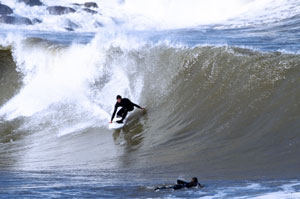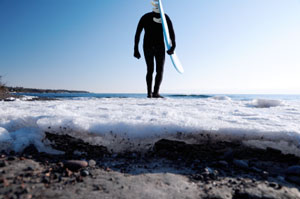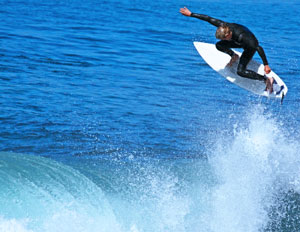How to Surf in Cold Water
April 01, 2024

The general public’s conceptual image of surfing is one that takes place exclusively in waters fronted by tropical, white-sand beaches. But the reality is that for many of us, surfing is often a cold, lonely experience. Countless locations far removed from the equatorial heat of the planet host a variety of great waves, as well as groups of surfers who ride them.
But for the beginning surfer, or even a relocated surfer living in a cold-water climate for the first time, frigid air and water temps are daunting and may thwart one’s desire to surf. Fear not.

In this new millennium, vastly improved wetsuit technology along with general overcrowding has turned spots once reserved for crazed diehards into all-accessible beach front. For better or worse, the farthest reaches of the globe are now officially open to the surfing public.
Suit Up
Before you invest your hard-earned cash, you’ll first want to educate yourself on all the basics of wetsuits, which you can find in the iSport guide, “How to Choose and Care for Your Wetsuit” (link to the right). The rudimentary points are as follows:
- There are several different types of wetsuits, each one offering a different amount of coverage. For cold-water surfing, you’re going to want a full suit, which covers both arms and legs.
- The thicker the suit, the warmer it will keep you. Wetsuits generally come in three, four, and six millimeter thicknesses.
- Not all wetsuits are created equal; generally, you get what you pay for. More expensive suits are more flexible, come with tape-sealed seams, and are usually more durable.
- Caring for your wetsuit will increase its lifespan. Since wetsuits are quite expensive, it’s important to rinse off the suit after every session to increase longevity.
Wetsuit Accessories
In addition to the wetsuit itself, you should also consider purchasing other wetsuit accessories depending on just how cold the water will be. For instance, if you’re surfing in water around 50 degrees, you’ll probably want to try wearing neoprene booties to prevent your feet from going numb. Booties are the most common wetsuit accessory because of the difficulties presented by surfing without feeling in your feet. Some surfers also wear gloves in chilly water.

Hoods are also a great way to increase your overall body temperature, especially in windy conditions or at spots where constant duck-diving is required. Some wetsuits come with built-on hoods (especially six millimeter suits), but you can also purchase them separately.
Warming Up
While your wetsuit is far and away the most important key to staying warm in the lineup, there are few additional tricks that can help you fend off the cold. Here are a few tips:
- Keep moving. The longer you sit still, the colder you’ll get. Keep your body heat flowing by staying active in the lineup. If you’ve been sitting on the outside for a while, paddle to the inside.
- While you’re sitting on your board, tuck your hands in your armpits. It may sound silly, but this little trick will warm your hands up if you aren’t wearing gloves.
- Drink plenty of water before you paddle out. Studies show that dehydration makes it more difficult for your body to stay warm. Plus, you’ll have plenty of ammunition for your built-in heat dispenser unit. In other words, there’s nothing wrong with peeing in your wetsuit.
Changing
Ironically, the coldest part about cold-water surfing has nothing to do with surfing. Assuming you’ve got the proper wetsuit equipment, the freezing comes in the parking lot, changing in and out of your wetsuit.
Maximize your warmth by leaving your upper-layer of clothing on while you change into your suit. Whether it’s a parka, a sweater, or a flannel shirt, it’s guaranteed to be a lot warmer than going bare-chested in the wind. Also, try throwing on a ski cap or a beanie while you suit up.
Some surfers like to bring a bunch of warm water to the beach, and then pour it on themselves after they surf. You can do this by filling a plastic milk carton or a similar container with near-scalding water and letting it sit in your car while you surf. When you get back to the car, it’ll be a nice warm treat that can double as a before-work shower.
If you’re really hardcore (as many surfers in freezing places are), invest in a van or a large vehicle that you can go inside when you change. That way, you can blast the car heater while you stow your board away, and then pop into the warm interior to change out of your suit. Not to mention, it’s a great place for a toasty nap in between sessions.
Conquer the Cold
Unless you’re a polar bear, there’s not much to like about cold-water surfing. It can be cumbersome because of all the added gear, and it can be uncomfortable.

But on the bright side, cold weather and water usually keep the crowds in check by separating the dedicated from the fair-weather masses. And more importantly, there are countless perfect, cold-water waves that are just waiting to be surfed!



